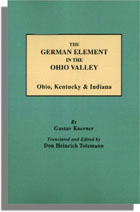
|
|
|
| Product Information: | ||
| Details: | The German Element in the Ohio Valley: Ohio, Kentucky & Indiana; by Gustav Koerner. Translated and edited by Don Heinrich Tolzmann; 144 pp ; Published: 2011; Paperback; ISBN: 9780806355078; Item: CF9265D In 1880 Gustav Koerner (1809-96), one-time Lieutenant-Governor of Illinois and confidant of Abraham Lincoln, published a comprehensive history of Germans in America entitled Das deutsche Element in den Vereinigten Staaten von Nordamerika, 1818-48. Dr. Don Heinrich Tolzmann has here translated and edited selected chapters from Koerner covering the states of Kentucky, Ohio, and Indiana and adding extensive references to additional sources. This marks the second volume adapted by Dr. Tolzmann from the Koerner opus; The German Element in the North East: Pennsylvania, New York, New Jersey and New England was published in 2010. Disinclined to write a history of German immigration to the United States, Gustav Koerner set about to describe and assess the 19th-century contributions--his coverage substantially exceeded 1848--of Germans to American life and society. In this context he considers the role of Germans and German-Americans in helping to establish Cincinnati as the center of Ohio Valley commerce, the plethora of German-language newspapers, the various religious denominations, the German Democratic Party, struggles against Nativism, Germans in the American Civil War, and so forth. For the most part, however--and genealogists are the beneficiaries--the work portrays the German element through the lives of individuals. Accordingly, Koerner offers a wealth of biographical information about people such as Martin Baum, Wilhelm Nast, Dr. Joseph H. Pulte, Heinrich A. Ratterman, Georg Walker, Ludwig Rehfuss, General Gotfried Weitzel, Nikolaus Hoffer, Pastor August Kroll, Gustav Tafel, Christian Heyl, Wilhelm Schmidt, Johann H. Ropke, G. W. Barth, Albert Lange, Johann Georg Rapp, and many others. Even better, researchers will find more comments concerning Koerner’s subjects and their families and careers in Mr. Tolzmann’s annotated footnotes to the text itself, making this translation an important addition to the literature of 19th-century German-Americans. |
|

